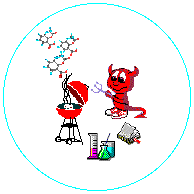MICROWAVE
ENHANCED SYNTHESIS OF ACRIDINES. |
 |
[A0068]
Julio A. Seijas*, M. Pilar Vázquez-Tato*, M. Montserrat Martínez and
Jacobo Rodríguez-Parga
Departamento de Química Orgánica. Facultad de Ciencias. Universidad de Santiago de Compostela. Aptdo. 280. 27080-LUGO. SPAIN
E-mail: [email protected] , [email protected]
Received: 4 August 2000 / Uploaded: 5 August 2000
Acridines are a well kown group of compounds [1] with a wide variety of biological properties [2]: DNA intercalating agents, anticarcinogenic, bactericidal, antimalarial, insecticides and antifungic. There are several aproaches to their synthesis. Bernthsen reaction is one of the classical methods. It is mainly the heating of diphenylamine in the presence of zinc chloride and a carboxylic acid, temperature of reaction is 200-210ºC and reaction times are several hours. But usually the yield are low.
In our group we are interested in the application of microwave heating to organic synthesis [3], usually this reactions employ a domestic microwave oven and reaction vessels are just test tubes or beakers opened to the air. Bernthsen reaction seemed to be an ideal candidate to substitute conventional heating by microwave heating.
We first just mixed reactants (diphenylamine, zinc
chloride and benzoic acid), in the stoichiometry used in literature (entry 1) in five
minutes we obtained just 34% of 9-phenylacridine. We thought that it might be the
great excess of zinc chloride, thus we reduced it to two equivalents achieving a rise in
the yield up to 80% (entry 3), with a ratio 1:1:1 diphenylamine:benzoic acid:znc chloride
we obtained a 98% yield (entry 2). We also tried to check the influence of the ratio of
benzoic acid but as it is shown in table it only led to lower yields.
| entry | diphenylamine | benzoic acid | ZnCl2 | time (min) | yield (%) |
| 1 | 1 | 1 | 5 | 5 | 34 |
| 2 | 1 | 1 | 1 | 2.5 | 98 |
| 3 | 1 | 1 | 2 | 4 | 80 |
| 4 | 1 | 3 | 1 | 3 | 69 |
Irradiation in a microwave oven proved to be a good way to optimize the Bernthsen reaction reducing the reaction time, reducing ammount of zinc chloride and raising considerably the yield of the "classical" method. Actually we are checking the behaviour of another carboxylic acids in their hability to yield 9-substituted acridines to see if our contribution to the synthesis of acridines is of general application.
Acknowledgments: DGES PB96-0937
REFERENCES:
1.- "Acridines. The Chemistry of Heterocyclic Compounds. R.M.
Acheson. Interscience Publishers Inc; New York (1956).
2.- McConnanghis, A. W. and Jenkins T. C.; J.Med:Chem.,
(1995). 38, 3488-3501.Lorente, A.; Fernández Saiz, M.; Espinosa, J. F.; Tetrahedron
Lett, (1995), 36, 5261-64. Lourdan, M.; García, J. and Lhommen, J.; Biochemistry,
(1999), 38, 14205-213. Bonse, S., Santelli-Rouvier, C., Barbe, J.,
Krauth-Siegel, R. L., J. Med. Chem.; 1999, 42; 5448-5454. Gamage, S.
A., Spicer, J. A., Atwell, G. J., Finlay, G. J., Baguley, B.C., Denny, W. A.,
J. Med. Chem.;; 1999; 42; 2383-2393. Lhomme, J. ; J. Med.
Chem.; 1997, 40, 3346-3352. Denny, W. A.; J. Med. Chem.;
1996; 39; 2508-2517.
Kirk, S. R., Luedtke, N. W., Tor, Y. ;J. Am. Chem. Soc.; 2000; 122;
980-981.
3.- Váquez-Tato, M. P., Synlett, (1993). Seijas, J. A., Vázquez-Tato, M. P., Martínez, M. M., Núñez-Corredoira, G. J. Chem. Res. (S), (1999). 420-421. Seijas, J. A., Vázquez-Tato, M. P., Martínez, M. M. Tetrahedron Lett.(2000), 41, 2215-2217.
 |
All comments on this poster should be sent by e-mail to (mailto:[email protected]) [email protected] with A0068 as the message subject of your e-mail. |  |